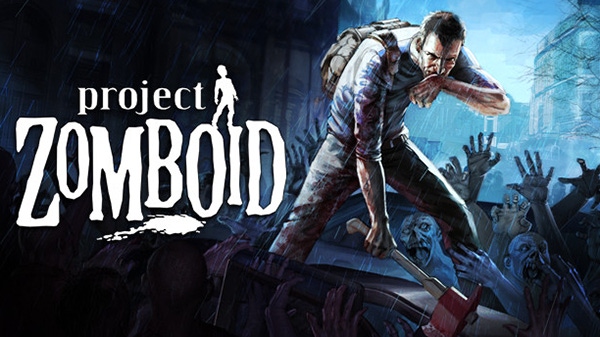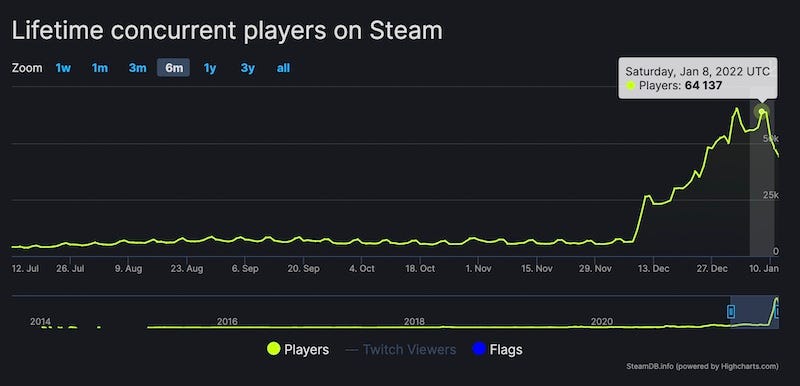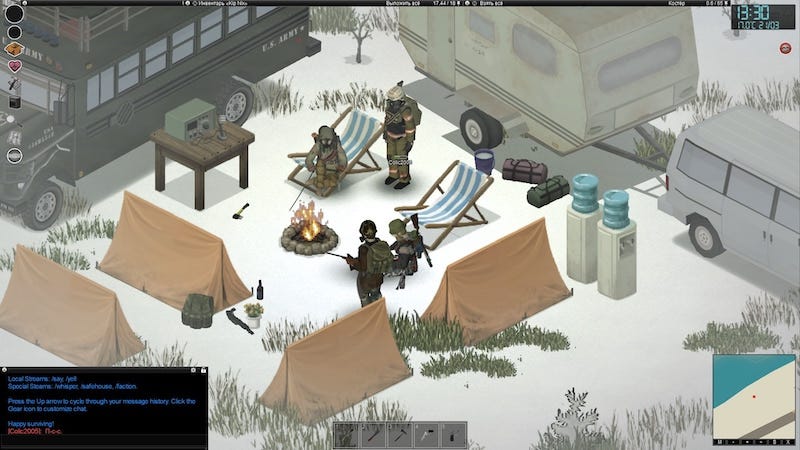Trending
Opinion: How will Project 2025 impact game developers?
The Heritage Foundation's manifesto for the possible next administration could do great harm to many, including large portions of the game development community.

Featured Blog | This community-written post highlights the best of what the game industry has to offer. Read more like it on the Game Developer Blogs or learn how to Submit Your Own Blog Post
It's... not a small increase, is it?

[The GameDiscoverCo game discovery newsletter is written by ‘how people find your game’ expert & GameDiscoverCo founder Simon Carless, and is a regular look at how people discover and buy video games in the 2020s.]
Welcome, Internet - we’ll be your server for the 24 hour greasy diner of newsletters, the GameDiscoverCo newsletter. The good news? We promise all natural, corn-fed information, no reheating of old material, and only organic video game discovery elements.
The bad news? We have dumb newsletter intros.
Some of you may be aware that suddenly, we’re seeing a game called Project Zomboid in the Steam Top 10-grossing games of the week. In fact, it’s all the way up at #4 in last week’s Steam charts, sandwiched between Monster Hunter Rise & the new Five Nights At Freddy’s game (!)
You might also vaguely remember that Project Zomboid - an isometric zombie survival game, btw - has been around on Steam for a long time. We believe that it’s the longest-running Steam game still in Early Access, according to this list. It’s been on Steam since 2013, and its first version was released all the way back in 2011 (!)
To be clear, PZ has always been popular. It’s had 40,000 Steam reviews LTD through the end of November. And in looking around, I was impressed with both the depth of its ‘painstakingly survive the zombie apocalypse at all costs’ gameplay, and the strength of its modding scene & its community-centric GaaS dev approach.
Starting in 2020, the game started surging to new heights, in part thanks to streamer support. This blog post from November 2020 reveals a new high peak CCU of over 5,000 at that time. (We recommend watching the ‘can I survive as an underweight, weak basket case?’ YouTube video that helped spawn that high, btw.) But look at the game’s Steam CCU in recent weeks:

Yes, that’s a 64k CCU high, wow! And it’s with the multiplayer patch for the game - officially released on December 20th but available in Beta earlier in December - that the game has gone through the roof with players. And with streamers, actually, if you look at Sullygnome’s Twitch stats for the game.
So yes, adding 32-person multiplayer and Minecraft-style dedicated servers on top of a game that had already been a decade+ in development is a great way to have a smash hit on Steam. Easy, huh? And luckily, we had a chance to chat to Project Zomboid co-creator, The Indie Stone’s Chris Simpson about how this all went down:
Were you surprised about the virality increase in taking Project Zomboid multiplayer? Do you think this interest spike is being fueled by Twitch, YouTube, TikTok, existing users recommending, or all of the above?
I think it’s likely a combination of all the things you mention, all contributing to fuelling us to stay in the top ten and be in line of sight of more potential customers.
We definitely knew there was a lot of potential there, from our feedback from our community during the single player beta, and seeing where players were looking for roleplaying opportunities in games that cater to it. We knew that, if we stuck the landing of the MP release, that things could go gangbusters. However, the sheer magnitude of it is something we could never have expected.
We also clearly had a huge existing customer base of over 2 million players that we’ve been slowly accumulating over the past decade. So bringing a lot of those players back all at once, along with the viral effect of them wanting to play multiplayer with their friends, is probably another prime factor in how it grew so rapidly on its release.
I know you'd rolled out some versions of multiplayer back in 2014 or so. Why did you decide to not pursue that further, and what made you decide to try to put multiplayer back in as a core part of the game again?
In short, our old multiplayer tech was extremely janky. We suffered from extreme memory usage on servers, servers frequently fell over or were overworked resulting in severe map streaming issues, we had terrible rubber banding and character movement - the list goes on…
It was functional enough that our dedicated fanbase got enjoyment out of it. But we'd never have stood a chance if we kept it like that that for the new build. We made such an effort to improve the character animation systems to make for a more immersive experience in Build 41 that having their movement become so rough on multiplayer would have been a terrible shame.
We felt a complete rewrite of the multiplayer architecture was the only sensible option. We took our ideas in terms of how to structuring a new MP framework to fit our game and prioritize what’s important in the PZ experience to our friends at General Arcade – an awesome third party development and porting house that we have now been working with for many years. They had the skills and experience necessary to write extremely solid multiplayer. And with our powers combined, we created something pretty special.

What's the biggest negative of 'going big' with a multiplayer game like you currently are? Server limit issues, hacking/cheating, dev crunch issues to fix bugs, or all of the above?
Ask us in a few months, I guess! It's hard to see any negatives at the moment. We've been very upfront that at the moment our server security requires improvement, and that people running servers would be strongly advised to run whitelisted servers with their communities or friends.
We'll be looking into anti-cheat solutions in the near future. And it'll be interesting how that'll work, not least because we're a highly moddable and open Java-based game - it may be an interesting challenge trying to combat hackers.
At the moment we're being somewhat conservative with our player counts, fixing it at 32 players. This seems to be a good number to allow players to feel their servers are sufficiently populated, without stressing the servers too much.
We have plans to expand this significantly. But I think the main thing is that we managed expectations by underlining that playing co-op with your friends was our top priority - and everything else was to be seen as a bonus.
Can you talk about your country breakdown for the game - what's your lifetime sales per country by percentage, and has that changed with the multiplayer version rollout?
A: In its entire history, 26% of our customers have been in the U.S, along with 12% in both China and Russia, followed by the UK and Canada. This has actually been pretty consistent compared to the last month, with the U.S., China and Russia still leading the way. The only difference is that Brazil managed to creep above the UK and Canada.
Also, on units sold - I'm presuming a lot of people returned to the game because of multiplayer, but can you talk about new buyers? In an average week, are you getting significant multiples of new purchasers, year on year?
It's a little hard to quantify, as we had the Holiday Sale situated in the middle of our recent spike. We're seeing about 13x the sales we saw in the previous month before the MP release, which obviously is heavily skewed because of the sale.
We sold 6x more units last Saturday compared to a Saturday at the start of December. But even that's probably underselling the uptick due to the fact that there was some increased attention due to the approach of our multiplayer release.
We did however in the past month sell 23x the units that we did in the same period over last year's Holiday Sale!
For many, many years we’ve had what we’ve called ‘the drip’ – which are the baseline sales that have never really wavered day-to-day (too much) over the whole of our ten years of development. It’s too early to tell what the ‘new normal’ for this will be once all the excitement and Steam sale rush has died down a bit. But it will be interesting to see for sure.
Finally - it seems like you've kept working on this game for a lot longer than others would have - in part because of the enthusiastic community. Is this multiplayer spike a good-feeling payoff for you, or does it feel like another set of problems to tackle?
Oh, entirely the first thing. It's reinvigorated the entire team. It's no exaggeration to say that working on the same game for a decade starts to wear you down after a while: the desire to experience that 'new project' excitement. Everyone knows that the start of a project is more fun than finishing one.
However, we have a lot of love for the game. And more than anything, we want to create something special as our 'magnum opus' of sorts - we're unlikely to ever work on anything this expansive ever again. Finally seeing it break out and seeing all the wonderfully kind and complimentary comments on social media from people just discovering the game is great.
In particular, with the added social element of the multiplayer, it has been incredible and a joy to search (every 10 seconds for weeks) what people are saying about it - and watch the incredibly creative videos that people are putting out.
Most importantly too, it’s been so lovely seeing the joy that our own community seems to take from the game’s success. It feels like our community has become incredibly invested in seeing the game take off. That's been really touching to see.
[We’re GameDiscoverCo, a new agency based around one simple issue: how do players find, buy and enjoy your premium PC or console game? We run the newsletter you’re reading, and provide consulting services for publishers, funds, and other smart game industry folks.]
Read more about:
Featured BlogsYou May Also Like